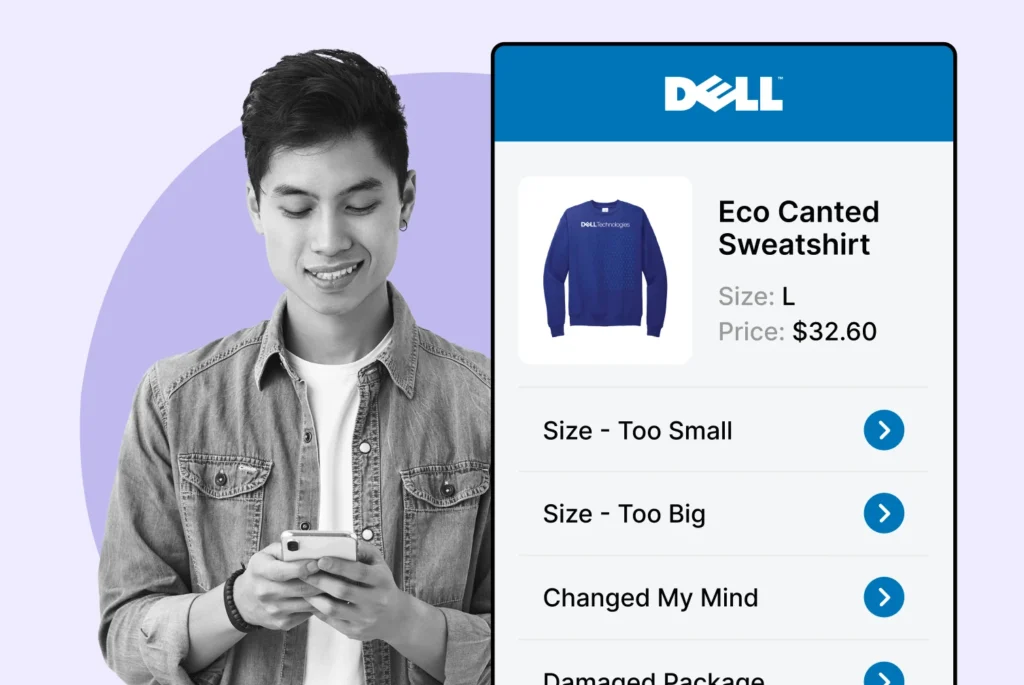
12 Expert Tips for Returns Management in eCommerce
Expert tips about returns management that will not only streamline your process but also protect your margins & elevate customer experiences!
Shipping, Tracking & Notifications
Boost customer experience and reduce support tickets
Realtime order and shipment tracking
Proactive order and shipping notifications
AI-Enhanced Discounted Labels
Predictive pre-purchase estimated delivery dates
Self-Serivce branded order tracking
Effortless experience delivered
Identify and Resolve Order Issues
Realtime order and shipment tracking
Make returns profitable and delight customers
Flexibility to define any return destinations & conditions
Simplify returns for your customers and team
Incentivize exchanges over returns
Returns management made easy for your team
Returns management made easy for your team
Easy claims and smart upsells
Understand why your customers are returning
In-Store & Curbside Pickup
Unify the online and the in-store experience
Hassle-free pickup experience for customers
In-Store dashboard to keep operations streamlined
In-Store and Online orders unified
Drive foot-traffic to your stores
Shipping, Tracking & Notifications
Boost customer experience and reduce support tickets
Realtime order and shipment tracking
Proactive order and shipping notifications
AI-Enhanced Discounted Labels
Predictive pre-purchase estimated delivery dates
Self-Serivce branded order tracking
Effortless experience delivered
Identify and Resolve Order Issues
Realtime order and shipment tracking
Make returns profitable and delight customers
Flexibility to define any return destinations & conditions
Simplify returns for your customers and team
Incentivize exchanges over returns
Returns management made easy for your team
Returns management made easy for your team
Understand why your customers are returning
In-Store & Curbside Pickup
Unify the online and the in-store experience
Hassle-free pickup experience for customers
In-Store Dashboard to keep operations streamlined
In-Store and Online orders unified
Drive foot-traffic to your stores
Boost customer experience and reduce support tickets
Realtime order and shipment tracking
Proactive order and shipping notifications
AI-Enhanced Discounted Labels
Predictive pre-purchase estimated delivery dates
Self-Serivce branded order tracking
Effortless experience delivered
Make returns profitable and delight customers
Flexibility to define any return destinations & conditions
Simplify returns for your customers and team
Incentivize exchanges over returns
Returns management made easy for your team
Equip your team for precise return checks.
Easy claims and smart upsells
Understand why your customers are returning
Unify the online and the in-store experience
Hassle-free pickup experience for customers
In-Store Dashboard to keep operations streamlined
In-Store and Online orders unified
Drive foot-traffic to your stores
Find the answer to all your questions
Take a step by step trip through our functionality to see how we can improve your ecommerce processes.
Explore the most comon questions about WeSupply
Calculate the ROI that WeSupply can bring you
Read actionable articles on how to optimize your post-purchase experience and decrease support tickets
Get inspired by stories of how our customers implemented an effortless post-purchase experience
Wondering if WeSupply is a good fit for you? Read through our use cases to see how we can help you increase conversion & improve CX!
A Deep Dive into Top Companies' Order Tracking & Returns Strategy
Find the answer to all your questions
Explore the most comon questions about WeSupply
Calculate the ROI that WeSupply can bring you
Request a no strings attached review of your current shopping experience and missed conversion opportunities
Take a step by step trip through our functionality to see how we can improve your ecommerce processes.
Read actionable articles on how to optimize your post-purchase experience and decrease support tickets
Get inspired by stories of how our customers implemented an effortless post-purchase experience
A Deep Dive into Top Companies' Order Tracking & Returns Strategy
Wondering if WeSupply is a good fit for you? Read through our use cases to see how we can help you increase conversion & improve CX!

Many businesses overlook the critical role of returns management in customer satisfaction and operational efficiency. To help you sidestep costly errors, this article outlines essential returns management mistakes to avoid. With these insights, you’re equipped to streamline your process and bolster your customer’s trust without any fluff or sales pitches.
A seamless returns process enhances customer loyalty and experience, driving repeat business and reducing operating costs.
Effective returns policies should be clear, comprehensive, and prioritize customer experience to foster trust and streamline operations.
Leveraging technology and returns data analysis can optimize the returns management process, prevent fraud, and improve customer satisfaction.
WeSupply streamlines returns management with automated processes, flexible rules, and data-driven analytics. This optimizes return policies, reduces fraud, and improves inventory management. By integrating in-store and online returns, offering eco-friendly solutions, and prioritizing customer feedback, WeSupply enhances efficiency and customer satisfaction. Start your FREE trial today!
Returns management is no longer a back-office function. It’s a front-line priority that directly impacts your customers’ experience and loyalty. In the world of e-commerce, 92% of shoppers will buy again if the return process is easy. Yet many businesses are still struggling to manage returns effectively, viewing them as isolated incidents rather than an integral part of the customer journey.
An efficient returns process goes beyond merely handling product returns. It’s about creating a better returns management process, one that encompasses the entire returns process, from the moment a customer initiates a return to the moment they receive their refund or exchange. In the following sections, we will explore ten common mistakes in managing returns, including an inefficient returns process, and provide insights on how to create a more efficient and customer-centric returns management process.
Effective returns management is more than just a cost-saving strategy; it’s a tool for building customer loyalty and driving revenue. When customers know they can count on you to process returns quickly and easily, they’re more likely to choose you over a competitor. In fact, the availability of free return shipping is a significant factor for 79% of online shoppers.
But the benefits of effective returns management extend beyond customer satisfaction. By optimizing the returns process, businesses can:
Reduce operational costs
Recuperate value from returned items through repurposing or resale
Contribute to faster turnaround times for repairing, refurbishing, or reusing products, which can decrease the necessity for new purchases
Identify opportunities to reuse, resell, or recycle materials, reducing waste and enhancing both the company’s profitability and its environmental responsibility.
Poor returns management can lead to a multitude of hidden costs. For starters, inadequate handling of returns can result in negative customer feedback, which can damage a brand’s reputation and lead to a decline in future sales. But the financial implications don’t stop there. Inefficient returns management can also lead to increased logistics and operational costs, from the transportation of returned items to warehouses or repair centers to the costs of labeling, checking, registering, and housing returned items in the warehouse.
But the costs of poor returns management aren’t just financial—they’re environmental too. Every returned item that ends up in a landfill contributes to carbon dioxide emissions and environmental waste. In fact, the US experiences over 33 billion pounds of CO2 emissions from return shipping annually. By viewing returns management as a strategic business function, businesses can avoid these hidden costs and turn returns into opportunities for growth and sustainability.
WeSupply, as a post-purchase software, ensures a seamless customer journey by enhancing transparency and communication. This builds trust and satisfaction throughout the customer experience.
Key Features:
Displayed on the product page, cart, checkout, and shipment notifications
Sets realistic expectations and builds customer trust by indicating order arrival times
Provides delivery dates, tracking information, and shipment updates
Mitigates anxiety and increases brand loyalty
Sends proactive updates on order and shipping status
Prevents customer inquiries by informing them of any delays or changes
Returns management made easy for your team and customers
Book a quick call with our experts to see how WeSupply’s self-service returns makes it super easy for your customers to return anything, anytime – without needing to submit customer support tickets or call in!
Experience the seamless and efficient customer journey with WeSupply, designed to enhance satisfaction at every step. Ready to transform your post-purchase process? Book a Demo today!
The second common mistake in returns management is having inadequate return policies. Complicated or unclear policies can confuse customers, leading to dissatisfaction and potentially damaging sales. A clear and concise return policy is not just a set of rules—it’s a communication tool that can build trust and encourage repeat business.
Crafting an effective return policy involves striking a balance between business needs and customer expectations. It should:
Be easy to understand
Be easily accessible
Provide a straightforward process for initiating returns
Clearly state what items are eligible for return
Clearly state how long customers have to return an item
Clearly state what return options are available (refund, exchange, store credit, etc.)
By creating a clear and concise return policy, businesses can set clear expectations for customers and streamline the returns process for both parties.
WeSupply addresses the challenges of inadequate return policies by offering flexible and customizable solutions that meet diverse customer needs. By allowing businesses to create smart return rules tailored to specific item attributes, WeSupply ensures a hassle-free and efficient return process.
Key Features:
Create Flexible Returns Rules:
Tailor return policies to match various item attributes
Set customizable conditions, such as free return shipping
Utilize intelligent dispositions to effortlessly sort physical returns
The third common mistake in returns management is ignoring fraudulent returns. While most returns are legitimate, there is a small percentage that are fraudulent, and these can severely affect revenue. Fraudulent returns can take many forms, from customers returning stolen items to customers using products and then returning them.
To minimize return fraud, businesses need to implement the following strategies and technology:
Tracking return patterns to identify suspicious behavior
Implementing rigorous return verification processes
Using technology to validate return requests
By taking a proactive approach to preventing return fraud, businesses can protect their revenue and maintain the integrity of their returns process.
With the pre-built return policies mentioned in the section above, you can combat fraudulent returns by targeting serial returners, protecting your revenue and ensuring a fair return process. Here are a couple of pre-built policies that can help you achieve this:
Reduce Return Fraud for Serial Returners:
Implement measures to identify and mitigate fraudulent return activities
Protect revenue by preventing abuse of the return policy
Blocklist Fraudulent Customers:
Use blocklisting of email addresses or customer groups to prevent fraudulent returns
Safeguard business interests by maintaining a secure return process
The fourth common mistake in returns management is underutilizing technology. In today’s digital age, technology plays a crucial role in streamlining and optimizing the returns process. Yet many businesses are still relying on outdated processes that can delay returns and increase costs.
Leveraging technology can automate and optimize return requests and reverse logistics, making the returns process faster and more efficient for both businesses and customers. This might involve:
Using returns management software to manage and track return requests
Using AI to automate customer communication during the returns process
Using data analytics to gain insights into return patterns and trends
WeSupply enhances returns management by leveraging technology to streamline and automate the entire process, saving significant time and reducing errors. This ensures a seamless and efficient returns experience for both businesses and customers.
Key Features:
Automate and streamline the return process
Reduce returns fraud and human error
Collect images and feedback
Integrate with existing workflows, ERPs, or 3PLs
Autogenerated QR Code Return Labels: Simplify returns by allowing customers to use QR codes without needing to print labels
Returns Tracking: Enable customers to track their returned products and check status easily
Post-Purchase Notifications: Send return shipping notifications via email and SMS, with high open rates, and offer personalized deals
Integrations: Connect with hundreds of third-party tools and APIs for a seamless experience
Returns Analytics: Identify most returned products and reasons, track serial returners, and gain actionable insights to reduce return rates
WeSupply’s advanced technology simplifies returns management, enhancing efficiency and customer satisfaction. Ready to transform your returns process? Book a Demo today!
The fifth common mistake in returns management is not analyzing returns data. In the world of e-commerce, data is king. It provides valuable insights that can inform business strategy and drive improvements. Yet many businesses are failing to tap into the wealth of data generated by returns.
Using analytics can help businesses identify trends and patterns in returns, uncover underlying issues, and develop targeted solutions. For instance, if a particular product has a high return rate, it might indicate a problem with the product’s quality or its product description on the website. By leveraging data, businesses can make informed decisions and continuously improve their returns process.
WeSupply helps businesses harness the power of returns analytics to improve product offerings, streamline processes, and enhance customer satisfaction. By providing detailed insights into return reasons at the product and variant level, businesses can make data-driven decisions to boost profitability and customer lifetime value.
Key Features:
Collect Product Feedback: Gather customer feedback to understand and address product issues
Analyze Financial Impact: Understand the revenue lost to returns and the cost of returns
Returns Analytics for eCommerce Business
Understand why your customers are returning: Identify the most returned products, Understand why those products are returned, Identify which customers are serial returners, Reduce Return Rate with Actionable Insights. Returns data available in BigQuery
Returns by Region: Analyze returns data by region to identify trends and patterns
Return Reason: Pinpoint specific reasons for returns to improve products and policies
Optimize Return Rates: Use insights to develop strategies that reduce return rates and increase revenue
Operational Efficiency: Anticipate return volumes and allocate resources to process returns efficiently
The sixth common mistake in returns management is inadequate integration of in-store and online returns. With the rise of omnichannel retail, customers expect a seamless experience across all channels, including returns. Yet many businesses have inconsistent returns policies across their in-store and online platforms, which can confuse customers and harm sales.
Creating unified policies for in-store and online returns is crucial for providing a consistent customer experience. This might involve allowing customers to return online purchases through in store returns or providing the same return options (refund, exchange, store credit) across all channels. By integrating in-store and online returns, businesses can meet customer expectations and streamline the returns process.
WeSupply bridges the gap between in-store and online returns, creating a seamless and integrated experience that drives customer satisfaction and additional revenue. By offering flexible return options, businesses can enhance convenience for their customers while boosting in-store traffic and sales.
Refund to Store Credit, Gift Card, or Coupon Code: Offer refunds as store credits to encourage repeat purchases and build customer loyalty
The seventh common mistake in returns management is inefficient inventory management. When returned items are not processed and restocked in a timely manner, it can disrupt inventory management and lead to stock discrepancies. Streamlining the process of receiving, checking, and restocking returned items can help businesses maintain accurate inventory levels and reduce wastage. This might involve using inventory management software to track returned items in real-time or implementing processes to quickly assess the condition of returned items and determine whether they can be resold, repaired, or recycled. By optimizing inventory management, businesses can reduce costs and improve overall efficiency.
WeSupply enhances inventory management by improving the process of inspecting returns and managing restocks. By defining quality check criteria, collecting product images and customer feedback, and allowing warehouse staff to leave notes on return inspections, businesses can ensure that only high-quality products are restocked. This meticulous approach to returns inspection helps maintain inventory quality and optimizes stock levels.
The eighth common mistake in returns management is overlooking the environmental impact. Every returned item that can’t be resold or reused contributes to waste and carbon emissions. Yet many businesses discard non-resellable returns without considering the environmental implications.
Implementing sustainable return policies can help businesses minimize waste and promote environmental responsibility. Some ways to do this include:
Offering a repair service for faulty items
Partnering with recycling companies to dispose of non-resellable items responsibly
Donating returned items to charity
By considering the environmental impact of returns, businesses can contribute to sustainability and enhance their brand reputation.
WeSupply helps businesses address the environmental impact of returns by implementing eco-friendly solutions that enhance customer satisfaction and reduce waste.
Key Features:
Automatic Return Labels: Enable customers to generate return labels automatically, even when staff is unavailable
Printerless Returns via QR Code: Improve customer experience by allowing returns without a printer, using QR codes for shipping labels
Intelligent Dispositions: Direct returns to appropriate channels, such as recycling centers, to make a positive environmental impact
It is important to prioritize exchanges as part of returns management. This can be the ninth common mistake to avoid in this process. When a customer returns an item, it’s an opportunity to retain their business by offering an exchange. Yet many businesses automatically issue a refund without offering the option of an exchange, resulting in lost revenue opportunities.
Encouraging exchanges can help maintain customer engagement and satisfaction. Here are some strategies to consider:
Suggest alternative items at the point of return
Offer incentives for exchanges, such as a discount on the next purchase
Make the exchange process as easy as possible
By prioritizing exchanges, businesses can retain revenue and strengthen customer relationships.
WeSupply helps businesses prioritize exchanges over returns, converting potential refunds into sales and enhancing customer satisfaction. By offering flexible exchange options and incentivizing store credits, WeSupply ensures a seamless and profitable return process.
Key Features:
Incentivize Exchanges: Save sales and boost average order value with instant store credit
Refund to Store Credit, Gift Card, or Coupon Code: Encourage repeat purchases and build customer loyalty by offering store credits
Exchanges turn returns into opportunities for revenue generation and a good example is the Evereve Case Study.
Evereve faced significant challenges managing orders and returns, with a highly manual process and no visibility into return reasons. Their goal was to streamline returns, reduce friction, and enhance customer loyalty. By integrating WeSupply’s technology, Evereve automated returns, centralized management, and emphasized proactivity, self-service, and return flexibility. This resulted in cost savings, faster and more accurate returns, and a streamlined customer experience. The transformation enabled self-service returns, reduced shipping costs, and improved employee productivity, turning returns into opportunities and boosting overall performance. Read the full case study to learn more about Evereve’s transformation with WeSupply Labs.
The tenth and final common mistake in returns management is ignoring customer feedback. Customer feedback is a valuable resource for continuous improvement. It provides insights into what’s working, what’s not, and how the returns process can be improved. Yet many businesses fail to use this feedback to enhance their products and services.
Building policies that adapt based on feedback can help businesses meet customer needs and enhance their services. This might involve:
regularly surveying customers about their returns experience
implementing changes based on feedback
using feedback to improve product quality and reduce return rates
WeSupply empowers businesses to harness customer feedback and drive continuous improvement. By integrating analytics and a data-driven decision process, WeSupply ensures that businesses can track and measure their post-purchase efforts effectively. Tools like Customer Satisfaction (CSAT) and Net Promoter Score (NPS) allow businesses to identify what they are doing right and pinpoint areas for improvement. This constant fine-tuning leads to an exceptional customer experience, delighting loyal customers and addressing any issues promptly.
Avoiding these ten common returns management mistakes is crucial for any business that wants to thrive in the competitive world of e-commerce. But more importantly, it’s about adopting a mindset of continuous improvement. It’s about viewing returns not as a cost to be minimized, but as a strategic opportunity to enhance the customer experience, drive loyalty, and improve profitability.
Effective returns management is no longer a nice-to-have; it’s a must-have for long-term success. By viewing returns management as a customer-centric function, businesses can meet and exceed customer expectations, build stronger relationships, and create a sustainable competitive advantage. Implementing a returns management system can help streamline this process. So, let’s start seeing returns not as a problem, but as a solution.
Let’s turn the challenge of returns into the opportunity of a lifetime.
In conclusion, returns management is an essential component of today’s e-commerce landscape. By avoiding the common mistakes discussed in this blog post, businesses can transform their returns process from a cost center into a strategic advantage. From improving customer satisfaction to enhancing operational efficiency to promoting sustainability, the benefits of effective returns management are clear.
WeSupply helps businesses avoid common returns management mistakes by providing a comprehensive suite of tools that streamline processes, enhance customer satisfaction, and boost operational efficiency. With features such as automated returns management, flexible returns rules, intelligent dispositions, and data-driven analytics, WeSupply enables businesses to optimize their return policies, reduce fraud, and improve inventory management. By integrating in-store and online returns, offering eco-friendly solutions, and prioritizing customer feedback, WeSupply ensures a seamless and profitable return process. Enhance your returns management and customer satisfaction with WeSupply. Get started with WeSupply today!
A good return policy should offer customers a reasonable amount of time, such as thirty to sixty days, to make a decision about the product, showing that you value their time and business. Widening the returns window has been found to decrease the number of returns.
To manage customer returns, businesses should create a clear return policy, establish an efficient return process, train staff on return handling, and provide excellent customer service. Additionally, analyzing return data for trends and taking proactive steps to prevent future returns are important measures to effectively manage customer returns and improve overall customer satisfaction.
WeSupply allows customers to order online and ship to store, return online purchases in-store, and return store purchases online. Refunds can be issued as store credits, gift cards, or coupon codes.
WeSupply offers customizable return rules tailored to item attributes, sets conditions like free return shipping, and sorts returns efficiently with intelligent dispositions.
WeSupply automates and streamlines the return process, reduces fraud and errors, integrates with existing systems, and provides a branded returns portal and QR code return labels.
Yes. WeSupply has an Official Shopify App. You can download it and start integrating with your Shopify Store.
Yes, WeSupply has an official extension for Magento. The WeSupply x Magento integration allows for automating order tracking experiences, reducing customer inquiries, automating shipping email and SMS notifications, and providing a fully branded order tracking experience
Yes, WeSupply has an official BigCommerce App. You can integrate WeSupply with your BigCommerce store to improve your post-purchase customer experience.

Learn How To Create Successful Post Purchase Email Campaigns
Build an effective post-purchase email flow that helps you increase customer satisfaction and drive revenue growth!

Expert tips about returns management that will not only streamline your process but also protect your margins & elevate customer experiences!

Expect to unlock insights on refining your returns process for better customer retention and a healthier bottom line!

Transform your RMA from a logistical challenge into a competitive advantage: actionable strategies to fine-tune your return procedures!

Find out how to handle dropshipping returns effectively to keep your customers satisfied and your operations smooth!

Actionable insights: Perfect your return workflows and bolster customer trust, without getting lost in theory or fluff!

Increase customer satisfaction and profit margins! Actionable steps to manage returns smartly: minimize costs, recover revenue.

In this guide, we dive into optimizing these solutions, with a focus on how Shopify storefronts can particularly benefit.

How to turn the returns process from a cost center into a strategic advantage, all while keeping your customers happy and loyal!

How can your business reduce costs while keeping customers satisfied: Focused insights into optimizing your returns process!